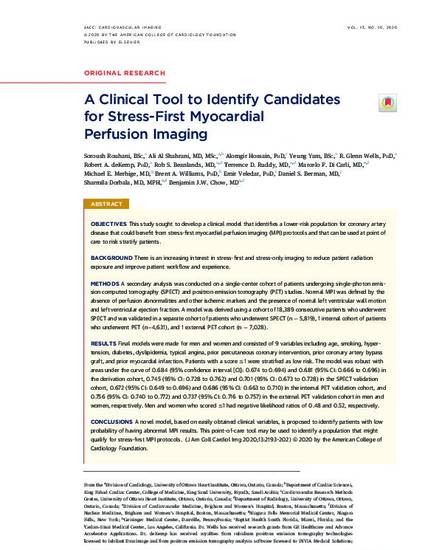
Objectives: This study sought to develop a clinical model that identifies a lower-risk population for coronary artery disease that could benefit from stress-first myocardial perfusion imaging (MPI) protocols and that can be used at point of care to risk stratify patients. Background: There is an increasing interest in stress-first and stress-only imaging to reduce patient radiation exposure and improve patient workflow and experience. Methods: A secondary analysis was conducted on a single-center cohort of patients undergoing single-photon emission computed tomography (SPECT) and positron emission tomography (PET) studies. Normal MPI was defined by the absence of perfusion abnormalities and other ischemic markers and the presence of normal left ventricular wall motion and left ventricular ejection fraction. A model was derived using a cohort of 18,389 consecutive patients who underwent SPECT and was validated in a separate cohort of patients who underwent SPECT (n = 5,819), 1 internal cohort of patients who underwent PET (n=4,631), and 1 external PET cohort (n = 7,028). Results: Final models were made for men and women and consisted of 9 variables including age, smoking, hypertension, diabetes, dyslipidemia, typical angina, prior percutaneous coronary intervention, prior coronary artery bypass graft, and prior myocardial infarction. Patients with a score ≤1 were stratified as low risk. The model was robust with areas under the curve of 0.684 (95% confidence interval [CI]: 0.674 to 0.694) and 0.681 (95% CI: 0.666 to 0.696) in the derivation cohort, 0.745 (95% CI: 0.728 to 0.762) and 0.701 (95% CI: 0.673 to 0.728) in the SPECT validation cohort, 0.672 (95% CI: 0.649 to 0.696) and 0.686 (95% CI: 0.663 to 0.710) in the internal PET validation cohort, and 0.756 (95% CI: 0.740 to 0.772) and 0.737 (95% CI: 0.716 to 0.757) in the external PET validation cohort in men and women, respectively. Men and women who scored ≤1 had negative likelihood ratios of 0.48 and 0.52, respectively. Conclusions: A novel model, based on easily obtained clinical variables, is proposed to identify patients with low probability of having abnormal MPI results. This point-of-care tool may be used to identify a population that might qualify for stress-first MPI protocols.
Available at: http://works.bepress.com/emir-veledar/379/
